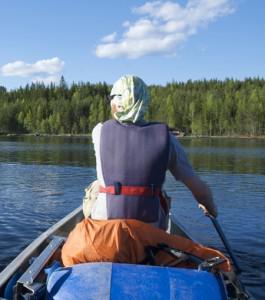 Sweden, with over 200,000 lakes and thousands of miles of rivers and waterways and its Right of Public Access, offers world-class possibilities for canoeing, and a self-guided canoe tour is one of the most popular choices for a holiday in Sweden for adults and families.
Sweden, with over 200,000 lakes and thousands of miles of rivers and waterways and its Right of Public Access, offers world-class possibilities for canoeing, and a self-guided canoe tour is one of the most popular choices for a holiday in Sweden for adults and families.
Like all outdoor activities, canoeing and wild camping carry an element of risk, and here are four of the most important things to consider before and during your tour:
- Wear your buoyancy aid at all times when on the water: No exceptions, even when canoeing on shallow flat water on a windless, sunny day. This sounds like such simple and obvious advice, and yet this most basic of points can be so easily forgotten or ignored. Remember that you do not need to be paddling rapids or out on a lake with windy conditions to capsize – most capsizes occur when getting in and out of the canoe! You may be a strong swimmer and an experienced paddler, but do not let this make you complacent when it comes to using your buoyancy aid. It may save your life. Plus, it keeps you warm!
- Plan your route but be flexible: Your itinerary should not be set in stone. Choose the shortest point to cross large areas of open water such as lakes, even if it means paddling a little further. Weather conditions change quickly, especially in mountain areas, and a flat-calm lake can suddenly become surprisingly choppy by the time you reach the middle. Plan extra time for contingencies. If the weather is against you, consider adjusting your route to paddle in more sheltered areas or stay closer to shore. And if you have to cross a large lake to continue with your tour, be prepared to simply pitch camp and enjoy the scenery until the weather improves.
- Don’t rely on your mobile phone: Mobile phones, while a valuable safety aid, are not infallible and we have come to rely on them far too much as a substitute for common sense and good planning. You may have no reception (particularly if canoeing in a wilderness area), your battery may be flat, or you may have just dropped your phone in the water. Bring a map (a paper one, in addition to your GPS!), bring a compass (preferably two!) and learn how to use them. Bring a First Aid kit and know how to use it. Make sure someone knows where you are going and when you should be back. Take relevant contact details for the canoe center as well as emergency numbers, etc, with you (on paper, not in your phone’s address book!).
- Take care with fires: Many people do not think of Sweden as a hot country with a high risk of forest fires, but in fact the forests can become very dry in summer and the risk of fire must be taken very seriously. Sweden’s Right of Public Access permits great freedoms for wild camping and the lighting of camp fires, and this is one of Sweden’s greatest assets as an outdoor destination. However, with this Right comes responsibility. Observe the guidelines you are given locally regarding the collection of firewood and lighting of fires, and bear in mind that nature reserves and other protected areas may have special regulations and that local restrictions may also be in place during high risk periods. When leaving a camping spot, make absolutely sure that your fire is extinguished by dousing it several times with several litres of water. An apparently dead fire can easily reignite. Take care with tents and sleeping bags, too. Keep fires well away from your equipment and never cook or use a naked flame inside your tent. If you are using a camping stove, place it on a secure base before lighting and never refill the fuel when the stove is still hot.
And most of all, relax and enjoy your tour and the beauty of the Swedish landscape. After all, that’s very good for your health too!
Guest post by Nature Travels, UK specialists for outdoor and ecotourism holidays in Sweden and Norway.
Photo by Euan Turner/DMh Photo.

